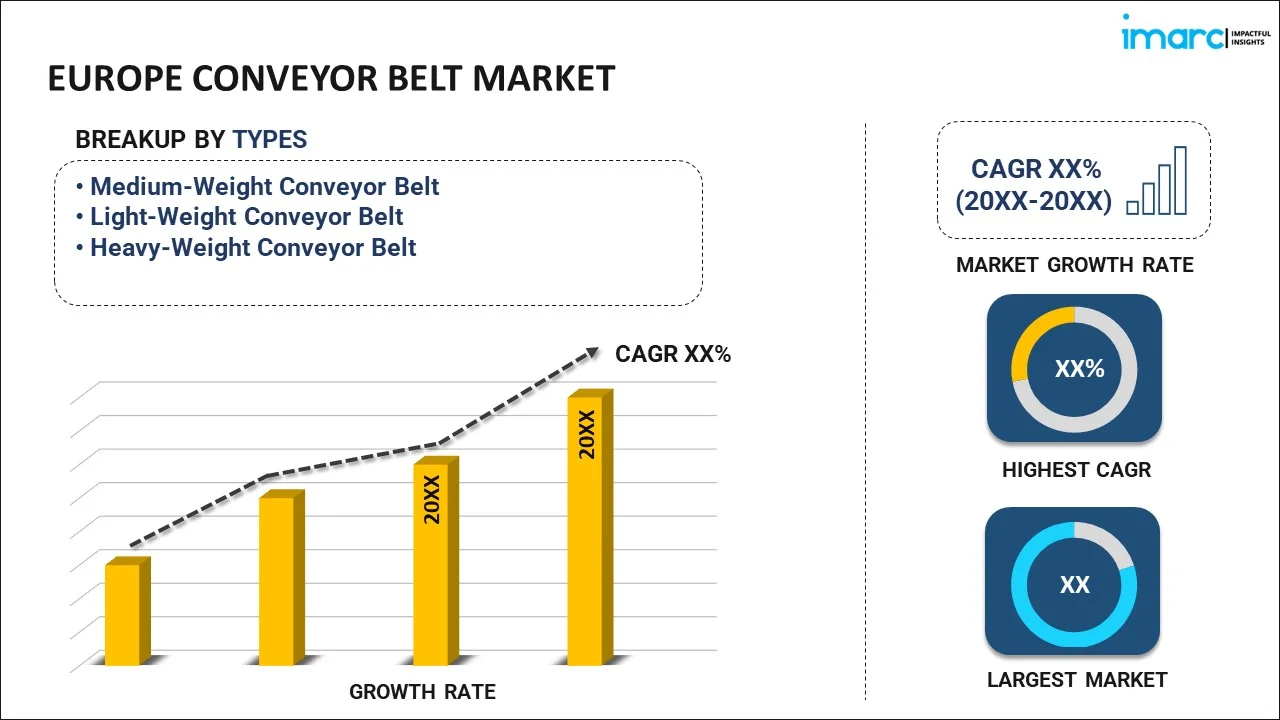
Europe Conveyor Belt Market Report by Type (Medium-Weight Conveyor Belt, Light-Weight Conveyor Belt, Heavy-Weight Conveyor Belt), End Use (Mining and Metallurgy, Manufacturing, Chemicals, Oils and Gases, Aviation, and Others), and Country 2025-2033
Market Overview:
The Europe conveyor belt market size reached USD 1.74 Billion in 2024. Looking forward, IMARC Group expects the market to reach USD 2.58 Billion by 2033, exhibiting a growth rate (CAGR) of 4.23% during 2025-2033.
|
Report Attribute
|
Key Statistics
|
|---|---|
|
Base Year
|
2024
|
|
Forecast Years
|
2025-2033
|
|
Historical Years
|
2019-2024
|
|
Market Size in 2024
|
USD 1.74 Billion |
|
Market Forecast in 2033
|
USD 2.58 Billion |
| Market Growth Rate (2025-2033) | 4.23% |
A conveyor belt is a carrying medium that consists of two or more pulleys used for transporting materials. It is commonly available in medium-weight, light-weight and heavy-weight variants. It is utilized for moving products in a straight line or through changes in elevation or direction and for providing controlled movement of the products. Conveyor belts are manufactured using metal, fabric, leather, rubber and thermoplastics. They are fire-resistant, cost-effective and convenient to use and aid in handling bulky materials. They find extensive application across various industries, such as aviation, manufacturing, chemical, oil and gas, mining and metallurgy.
The Europe conveyor belt market is primarily being driven by the increasing product adoption across the aviation industry for baggage handling. There is a rising demand for automation in handling materials to reduce cargo loss, accidents and enhance operational efficiency and productivity. Moreover, various product innovations, such as the launch of the industrial conveyor belts that are oil-resistant, self-extinguishing and heat and chemical resistant, are contributing to the market growth. The increasing demand for conveyor belts in the food and beverage industry to transport raw materials out of storage systems and moving the finished food products is also favoring the market growth. Additionally, the introduction of environment-friendly product variants with energy-efficient bulbs and automatic sleep controls are driving the growth of the market. Other factors, including the presence of a strong industrial sector, along with the widespread product adoption by ecommerce retailers to increase their delivery efficiency, are anticipated to drive the market towards growth.
Key Market Segmentation:
IMARC Group provides an analysis of the key trends in each segment of the Europe conveyor belt market report, along with forecasts at the regional and country levels from 2025-2033. Our report has categorized the market based on type and end use.
Breakup by Type:

- Medium-Weight Conveyor Belt
- Light-Weight Conveyor Belt
- Heavy-Weight Conveyor Belt
Breakup by End Use:
- Mining and Metallurgy
- Manufacturing
- Chemicals, Oils and Gases
- Aviation
- Others
Breakup by Country:
- Germany
- France
- United Kingdom
- Italy
- Spain
- Others
Competitive Landscape:
The competitive landscape of the industry has also been examined along with the profiles of the key players.
Report Coverage:
| Report Features | Details |
|---|---|
| Base Year of the Analysis | 2024 |
| Historical Period | 2019-2024 |
| Forecast Period | 2025-2033 |
| Units | Billion USD |
| Segment Coverage | Type, End Use, Country |
| Countries Covered | Germany, France, United Kingdom, Italy, Spain, Others |
| Customization Scope | 10% Free Customization |
| Post-Sale Analyst Support | 10-12 Weeks |
| Delivery Format | PDF and Excel through Email (We can also provide the editable version of the report in PPT/Word format on special request) |
Key Questions Answered in This Report
The Europe conveyor belt market was valued at USD 1.74 Billion in 2024.
We expect the Europe conveyor belt market to exhibit a CAGR of 4.23% during 2025-2033.
The sudden outbreak of the COVID-19 pandemic has led to the increasing adoption of conveyor belts across various sectors, such as Food and Beverage (F&B), packaging, logistics, etc., to automate numerous operations and limit human interaction in order to reduce the risk of the coronavirus infection across several European nations.
The emerging trend of industrial automation, along with the growing demand for advanced conveyor belts with self-cleaning properties, improved operational costs, high energy-efficiency, etc., is primarily driving the Europe conveyor belt market.
Based on the type, the Europe conveyor belt market has been divided into medium-weight conveyor belt, light-weight conveyor belt, and heavy-weight conveyor belt. Among these, medium-weight conveyor belt currently holds the majority of the total market share.
Based on the end use, the Europe conveyor belt market can be bifurcated into mining and metallurgy, manufacturing, chemicals, oils and gases, aviation, and others. Currently, the mining and metallurgy sector exhibits a clear dominance in the market.
On a regional level, the market has been classified into Germany, France, United Kingdom, Italy, Spain, and others, where Germany currently dominates the Europe conveyor belt market.
Need more help?
- Speak to our experienced analysts for insights on the current market scenarios.
- Include additional segments and countries to customize the report as per your requirement.
- Gain an unparalleled competitive advantage in your domain by understanding how to utilize the report and positively impacting your operations and revenue.
- For further assistance, please connect with our analysts.
 Inquire Before Buying
Inquire Before Buying
 Speak to an Analyst
Speak to an Analyst
 Request Brochure
Request Brochure
 Request Customization
Request Customization




.webp)




.webp)












